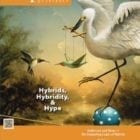
“Abundance: Oranges” by Kevin Sloan/www.Kevinsloan.com
In recent years, it has been exciting to observe all the innovative activity at the intersection of investment and philanthropy. Still, I am frustrated—for after all is said and done, the leaders and adherents of this movement (for simplicity’s sake, let’s call them “conscious investors”) are almost as cognitively constrained as the most traditional investor. They allow two strands of old-fashioned thinking to limit their innovations and ultimate effectiveness.
First, they remain largely stuck in silos established by the tax code, corporate identities, and the public/private company distinction. Second, their work is circumscribed by a set of limiting fiscal “truths” emanating from professional schools.
These strands prevent them, and the rest of us, from analyzing the world and the work of its enterprises as they really are.1 More importantly, they keep us from investing and granting as intelligently and farsightedly as we must for our communities and global society to achieve their potentials.
This article contends that it is time for conscious investors to think very differently. It holds that enterprises across traditional categories have more similarities than differences. It identifies the old-fashioned ways of thinking and “best practices” that limit our imaginations and potential. Finally, it suggests an alternative approach for assessing the holistic societal value of all enterprises, untethered from corporate identity or tax status.
The Technocrat’s Canon of Best Investment/Grantmaking Practice
The strategies of the “conscious investors” at the intersection of investment and philanthropy feature a glossary of evocative terms, such as: shared value; social impact bonds; impact investing; corporate social responsibility (CSR) reporting; benefit corporations; impact reporting and investment standards (IRIS); charting impact; balanced scorecards; sustainable procurement; social enterprise; social return on investment (SROI); environment, social and governance (ESG) screens; nonprofit business models; venture philanthropy; philanthropic equity; double and triple bottom lines; and blended value.
With all this new vocabulary, we should be excused if we can no longer determine where one tax status ends and another begins, or whether the profit motive is the principal driver of operational excellence, regardless of social motive. This vocabulary raises two fundamental questions that we’ve never seriously entertained: (1) Do the corporate forms and tax statuses we now almost invariably use to distinguish among enterprises actually blind us to their similarities, especially with respect to the basic work that they do and their impacts upon society? (2) Isn’t it time to focus on the full examination of each enterprise, both for- and nonprofit, as we make investment and grant decisions and construct our portfolios?
When we look at our commercial, nonprofit, and hybrid enterprises broadly and holistically—beyond the overlay imposed by state corporations commissions and the U.S. tax code—we find fundamental similarities across the board. These enterprises employ us and make possible the development of skills and experience throughout the workforce. They deliver goods and services, respond to our needs, and solve our problems. They build physical and technological infrastructure. They generate knowledge and spin out new enterprises. They also deplete natural resources, including a stable habitable climate, and have the potential to compromise public trust in our political and financial systems. They each have these types of fundamental impacts upon society—characterized inaccurately (and ill-advisedly) by economists as “externalities”—which result both from what they are in business to do and how they conduct their work. In these and many other ways, they impact the store of regenerative capital necessary to propel society through time.
Very few of our conscious investors are looking at the whole and what this remarkable change in vocabulary should mean for investment and philanthropy generally. Instead, they work independently to push distinct envelopes within traditional portfolio categories. Impact investing promotes newish, privately held “for-profit” social enterprises; venture philanthropy, philanthropic equity, and social impact bonds look for data-receptive, mission-focused “nonprofit” enterprises for their grant programs; ESG screens and CSR reports are directed toward publicly traded corporations in their equity allocations; and so on.
As with those who lead and govern the investment houses, foundations, consultancies, media, corporations, and leading nonprofits, the conscious investors’ freedom of thought is also constrained by a ubiquitous but limiting technocratic canon of best practice for investment and serious philanthropy, which holds that:
- All investments within a portfolio are intrinsically interchangeable financial risk/return cogs in an asset-allocation algorithm;
- Portfolios must be constructed by asset category, not by subject or substance of the work, contributions to society, or other non-fiscal factors;
- It is valid to ignore an enterprise’s operating activity (e.g., guns and tobacco) and unmonetized “externalities” to ensure a proper asset allocation in a portfolio;
- Proper valuation of any investment requires the deep discounting of its projected future “free” cash flows. The capital asset pricing model is sacrosanct, and reported quarterly results by corporations and money managers are the best indicators of enterprise worthiness and investors’ likely success;
- It is the duty of a commercial corporation to maximize its financial value—albeit determined by the market’s short-term preferences—for its shareholders;
- Any assessment of impact and social return must be measured to be valid;
- Strategic and venture philanthropy should be focused upon discrete, fast-returning projects with measurable impact that can “scale”;
- Financial engineering now competes credibly with operational excellence as a driver of progress; and
- Endowments must have inviolate, independent fiscal lives, quite apart from any ultimate social or academic context or purpose. The measure of an endowment’s success is financial: the market value of its corpus must keep pace or exceed inflation perpetually.
This canon of best practice is integrated into the core curricula of every professional school (not just MBA programs). Its laws are reinforced at every turn by an army of lawyers, accountants, and financial managers.2 Indeed, the day when we the investing public had a clue what specific equities were in our portfolios has long passed. The experts have taken over. The canon of best practice implies precision where none is possible. It removes personal values as a factor in investment decisions. It enforces a singular and severely limiting “asset-type” categorization of enterprises within portfolios. Despite its cognitive limitations, the innovators at the intersection of investment and philanthropy continue to respect and operate within the canon.
What if we aspiring conscious investors could put aside this limiting canon? What if we began demanding a full accounting of the impact on society of each enterprise, and made our capital deployment decisions accordingly?
Society’s Overall Inventory of Necessary Capital: An Alternative Framework
I ask that we work diligently to build an alternative framework that compels us to (1) assess the long-term value to society of each enterprise, regardless of its traditional category; (2) conduct that assessment holistically, thinking about how each enterprise operates, how it deals with other organizations, communities, and systems, how it sources its ingredients, and what products its makes—as well as how well it generates financial wealth; and (3) ensure that our values are fully engaged whenever we invest or grant funds.
In doing so, we would be returning to first principles, recalling that in the early days in the history of corporations, legislatures and kings reviewed prospective company activity and chartered those enterprises they expected would generate wealth directly and indirectly for society. It behooves a conscious investor to remember the antecedents of corporate formation and contemplate the components of that societal wealth—the inventory of critical capital that a society needs to progress and prosper over the long haul.
What are the components of a healthy society’s inventory of capital, and how might individual enterprises impact these? Certainly, financial capital is critical for society, in that it is necessary for the care and feeding of all enterprises. Further, each enterprise’s long-term contributions of financial capital are necessary to regenerate other forms of capital. But financial capital clearly is not the only type of capital that is required in a healthy society.
Access to a plentiful store of natural capital—a hospitable climate, clean air, clean water, fertile soil, minerals, energy, timber, and other natural resources, etc.—is a precondition for the existence and success of all enterprises. Through sourcing ingredients and creating products and services and ordinary business practices, enterprises have enormous impacts (positive and negative) upon society’s store of natural capital. Likewise, a healthy, engaged, trusting citizenry, imbued with civic or societal values, is an enormous source of wealth for every society. Enterprises can have substantial, and not always positive, impacts upon society’s civic capital.
Sign up for our free newsletters
Subscribe to NPQ's newsletters to have our top stories delivered directly to your inbox.
By signing up, you agree to our privacy policy and terms of use, and to receive messages from NPQ and our partners.
Society’s proper functioning requires a healthy component of systemic capital in the form of its physical (roads, bridges, waterways), communications, health, legal, safety, government, and financial systems. Some enterprises are formed to construct elements of society’s systemic capital—it is their business purpose. Beyond those enterprises’ direct contributions to society’s systems, all enterprises, through their payment (or nonpayment) of local, state, and federal taxes, and their uses of systems in the course of business, make positive or negative contributions. In the same way, an enterprise’s building of production, distribution, and transportation facilities and equipment, or physical capital, can comprise an important component of society’s overall capital inventory.
A healthy, prepared, productive, and motivated population—human capital—is critical for society’s progress. Enterprises contribute to society’s store of human capital directly, in the form of educational products and services, and indirectly, through development of their own employees. Respective contributions of human capital vary tremendously among enterprises. Similarly, society cannot progress or compete today without the continuous generation of intellectual capital—production/technological know-how, hard science, art, and social science. Enterprises contribute the intellectual capital developed in their own products and operating methodologies directly, as well as through spinoff enterprises.
Setting the Table for a World We Want
Each of our enterprises contributes or depletes the capital in society’s inventory in multiple ways. For example, a major packaged-food company credits its creation of “shared value” with respect to community nutrition, clean water, and rural development—systemic and intellectual capital—for its recognition as one of a major accounting firm’s top corporate reporters of corporate social responsibility. Others accuse the company of “greenwashing,” and maintain that the company’s ingredients sourcing and bottled water business deplete natural capital in developing countries, and that its products compromise the health of youthful consumers, and thereby the supply of human capital.
A major urban art museum may also generate a surplus, or financial capital, which it “reinvests” in its collection, physical plant or exhibitions, and staff capacity. Beyond finance, this nonprofit enterprise contributes significantly to the city’s civic, human, and intellectual capital through its training and public education programs as well as its public meeting places and prominence in the cityscape.
A big-box retailer offers middle- and lower-income consumers an immense variety of products—from groceries to firearms—at consistently low prices. It pursues state-of-the-art product sourcing, transport, inventory, and other operating-cost-control methodologies. These policies have generated considerable financial capital, and put the company at the top of the low-carbon-footprint league table. While it may score high with respect to natural capital, the company does less well on indicators of human capital development, and quite poorly with respect to fraying the economic fabric of its communities—their civic capital.
A registered B Corp and self-described social enterprise sources and distributes ten million healthy and affordable meals to primarily lowincome students each year, helping to build healthy bodies, lifelong nutritional habits, and human capital. The jury is out, however, with respect to the company’s net contributions to society’s capital. Thus far, the company is unprofitable and depleting its financial capital reserves. Further, it has caused the dismantling of traditional food delivery—a form of systemic capital—and there is no certainty its own tenuous economics will allow it to offer a long-term alternative.
While these examples may produce more drama than we’d find typically, all enterprises make multiple contributions to the capital of their communities—through their ingredients sourcing, programs, employment and operating practices, creativity, and participation in other activities that strengthen the fabric of society.
In this very real sense, any investment in or grant to any enterprise is an impact investment. But because we don’t examine most of our investments through this lens, we usually don’t know whether we are abetting net positive or negative impacts when we invest or grant our funds. We are setting the table for a world we may or may not want, yet we continue to let short-term edicts of a misplaced canon of best practice prevent us from thinking clearly, broadly, and long term.
For most of us who are used to mathematical “clarity,” precise modeling, and the convenience of the canon, taking that first serious look through a new, less precise contribution to society’s capital lens will be challenging. Indeed, it may prove more challenging than using other tools that promise to assess enterprise impacts holistically, such as B Corp and impact reporting and investment standards (IRIS), which use lists of questions and standards intended to elicit discrete, usually measurable or binary responses by participating enterprises. When looking through the contribution to society’s capital lens, the conscious investor will observe that each enterprise contributes to the components of society’s capital in different, often surprising ways, and that much of the important evidence regarding contributions to society’s capital will not be measurable. Instead, it will be hypothetical, not comparable among enterprises, and without an attributable causative impact.
Further, when we go to aggregate or reconcile this disparate body of evidence in order to estimate an enterprise’s net contribution to society’s capital, we will find ourselves weighing the importance of each variable—such as whether formation of financial capital outweighs natural capital degradation, or whether a high score on natural capital outweighs erosion of a formally vital downtown’s merchant base and civic capital. Such judgments will necessarily require the application of the investor’s personal values.
Generating the information necessary to support this decision framework will require a new level of diligence on the part of investors and intermediaries as well as cooperation and transparency on the part of enterprises. It will be especially challenging to overcome the entrenched quality and analytical elegance of the canon of best practices. The sophistication of the processes required to assess enterprise contributions to societies will grow through time and analytical experience.
My hope would be that in eschewing the simplicity and false precision of the canon and traditional categorizations of enterprises, conscious investors will begin to think broadly, holistically, and positively about what our enterprises really mean for the long-term success of our communities and society; that we will develop new methods that allow us to build satisfying portfolios of the enterprises that are generating the forms of capital that we, ourselves, believe are critical for our society’s future; and that we will change the fundamental factor in our decisions from a discounted estimation of future earnings to a values-driven estimation of the holistic contributions of our enterprises well into the undiscounted future. In doing so, we would send meaningful signals that would encourage the most contributory practices in all of our enterprises.
Notes
- All nonprofit organizations that pursue a mission, incur expenses, and generate revenue are considered “enterprises” in this article.
- This is particularly the case with respect to the army of professionals who advise private foundations—the institutions one might hope would be the most conscious of conscious investors.
Buzz Schmidt, principal of Building Wherewithal, is the founder of GuideStar and chair of the FB Heron Foundation.












